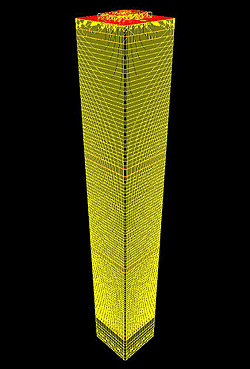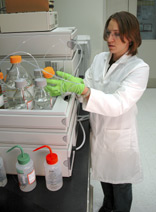|
September
28, 2004

[NIST
Tech Beat Search] [Credits] [NIST Tech Beat
Archives] [Media
Contacts] [Subscription Information]

World
Trade Towers Design Exceeded Wind Load Codes

|
Single
frame of a computer simulation (containing 90,000
elements) of the WTC North Tower as it responds to
wind loads.
|
The
National Institute of Standards and Technology (NIST) reported
on Sept. 17 that it has done additional analysis of the
wind “loads” that the World Trade Center (WTC)
towers were originally designed to resist—critical
data to help the agency better assess the overall strengths
and baseline performance of the two buildings before they
were brought down by the terrorist attacks of Sept. 11, 2001.
The work is being conducted as part of NIST’s federal
building and fire safety investigation of the WTC disaster.
NIST recently completed its review of the original 1960s-era
source documents containing wind tunnel test data and wind
load estimation methods used for the towers, calculated the
wind load estimates based on a clearer interpretation of this
information, and determined the values actually used in the
design of the buildings. These clarified original design wind
load estimates all exceed those established by the New York
City building code prior to 1968 (when the WTC towers were
designed) and through 2001 (when the towers were destroyed).
The values also are higher than those required by other selected
building codes of the era, including the relevant national
model building code.
Wind load capacity is a key factor in determining the overall
strength of a tall building and is important in determining
not only its ability to withstand winds but also its reserve
capacity to withstand unanticipated events such as a major
fire or impact damage.
The NIST
investigation team’s final report is scheduled
for release as a draft document in December 2004. For more
information on the new findings, go to www.nist.gov/public_affairs/releases/wtc_wind_loads.htm.
Media
Contact:
Michael
E. Newman, michael.newman@nist.gov,
(301) 975-3025


Studying
the Chemistry of Drugs in Wastewater

Photo
by Gail Porter/NIST
|
NIST
research chemist Mary Bedner prepares to use liquid
chromatography and mass spectrometry to analyze
the chemical byproducts produced by reacting pharmaceuticals
with chlorine.
Click
on image to download high-resolution version. |
What
happens to painkillers, antibiotics and other medicines
after their work is done, and they end up in the wastewater
stream? The National Institute of Standards and Technology
(NIST) is using laboratory experiments to help answer this
question by studying what happens to pharmaceuticals when
they react with chlorine—a disinfectant commonly used
in wastewater treatment.
Scientists
around the world often find drugs in water samples taken
from streams and other waterways, but little is known
about byproducts of those drugs created during chlorine treatment
or time spent in the environment. The topic drew a large
audience at the American Chemical Society annual meeting
last month, where NIST chemist Mary Bedner was one of several
presenters. Among the concerns is possible damage to the
environment, animals or people from bioactive compounds.
NIST
chemists selected four pharmaceuticals sometimes found
in the environment,
studied their reactions with chlorine
over an hour (a timescale during which significant wastewater
treatment occurs) and identified the resulting products using
multiple techniques. Scientists found that the reactions
are complicated and often produce several products, some
unexpected. For instance, acetaminophen forms multiple products,
two of which are highly toxic. All the drugs were
transformed significantly,
and their products were generally more "hydrophobic" than
the parent pharmaceuticals. Hydrophobic compounds are more
likely to build up in the body. It is not known whether these
reaction products pose any health or environmental hazards.
"We
have unique measurement capabilities here at NIST, which
help to confirm the presence of products that are
difficult to identify," says chemist William MacCrehan.
Measurement techniques and data collected throughout the
project should help other laboratories further investigate
possible health or environmental effects.
Media
Contact:
Laura
Ost, laura.ost@nist.gov,
(301) 975-4034


Fire
Prevention Tips for Saving Lives
How
old are the smoke detectors in your home? Any smoke detector
more than 10 years old should be replaced since the sensor
may be worn out. How long would it take your family to leave
the house if a fire occurred at night? Recent research has
found that once a smoke detector sounds your family may have
only about 3 minutes to escape safely.
 |
| In
a recent NIST lab test, flames from a simulated house
with combustible exterior walls ignite a similar "house" six
feet away. The numbers in the corner are the time (in
minutes) since the start of the test. |
To raise
awareness about fire safety tips like these that save lives,
the National Institute of Standards and Technology
(NIST) has updated five fact sheets for consumers in time
for National Fire Prevention Week on Oct. 3-9. The single-page
fact sheets include information on wood stoves, fire-places and
space heaters; smoke and carbon monoxide alarms, electrical
safety, home fire sprinklers, and emergency planning for
escaping home fires. The fact sheets were originally prepared
in conjunction with the U.S. Fire Administration and the
U.S. Department of Housing and Urban Development.
NIST
fire researchers conduct experiments in a broad range of
areas from testing the performance of smoke detectors
and sprinklers to investigating the fireproofing materials
used in the World Trade Center buildings. Special facilities
at the Institute's Gaithersburg, Md., laboratories can be
used for full-scale fire tests that simulate real-life conditions.
For example, a series of tests found that a fire caused by
an ignited holiday tree engulfed a living room in flames
in just 45 seconds. Other recent experiments showed that
a fire ignited in one mocked-up house structure spread to
a second structure six feet away in less than five minutes.
To print
copies of the five fact sheets, go to www.fire.nist.gov/factsheets.
For further information on other NIST fire research programs,
see www.bfrl.nist.gov/.
Media
Contact:
John
Blair, john.blair@nist.gov,
(301) 975-4261
Editor's
note: Broadcast quality video of recent NIST fire tests
is available upon request. Computer simulations using NIST's
Fire Dynamics Simulator and Smokeview software programs
are also available. NIST fire research experts are available
for interviews on a wide range of topics.


Helping
Investigators Gather Crime Evidence from PDAs
Tech
savvy criminals are just as likely as anyone else to use
high-tech devices, such as personal digital assistants
(PDAs), to help keep track of their activities. PDAs
are relatively inexpensive and highly portable and can
store documents, spreadsheets, databases and many other
resources usually associated with a laptop or desktop
computer. When these devices are used in a crime, law
enforcement investigators need to know how to find, properly
retrieve and examine the information they store, even
if the criminal tried to hide or delete the data.
Researchers
from the National Institute of Standards and Technology recently
examined a number of software tools designed to acquire information
from operating
systems used in most PDAs: Palm OS, Microsoft Pocket PC and
Linux. The researchers examined the tools in a range of situations
commonly encountered during a forensic examination of PDAs.
For example, the researchers wanted to determine if tools could
find information, including deleted information, associated
with applications such as calendars, contacts and task lists.
The tools also were examined to see if someone could obtain
the user’s password and gain access to the contents of
the device.
NIST’s
review of the current state of the art of forensic software,
PDA Forensic
Tools: An Overview and Analysis (NISTIR
7100), will help investigators better understand the capabilities
and limitations of these software tools. Sponsored by the Department
of Homeland Security, the study was not intended
to be exhaustive or serve as
a formal
product
evaluation but to complement the more rigorous specifications
and test methods being developed as part of the Computer
Forensics
Tool Testing project. The CFTT is a joint effort of NIST, the
National Institute of Justice, and law enforcement organizations.
For more information on the CFTT, see www.cftt.nist.gov/.
The report is available at http://csrc.nist.gov/publications/nistir/index.html#ir7100.
A companion
NIST report, which provides more detailed procedures on preserving,
examining, analyzing and reporting of digital
evidence on PDAs, will be available soon. A draft of this publication,
Guidelines on PDA Forensics, is available at http://csrc.nist.gov/publications/drafts.html#sp800-72.
Media
Contact:
Jan
Kosko janice.kosko@nist.gov,
(301) 975-2767

Quick
Links
Thirty-two
New ATP Awards Announced
The
National Institute of Standards and Technology's
(NIST) Advanced Technology Program (ATP) has announced
32 new cost-sharing awards for research on highly
innovative industrial technologies. A total of
43 companies, including seven joint ventures, are
involved in the new projects, which were chosen
on the basis of difficulty, technical innovation
and the potential for significant benefits to the
nation's economy.
The
32 new ATP projects span a broad range of key technology
areas and target new energy technologies for oil
exploration and for fuel cells, new medical diagnostic
and therapeutic technologies, improvements in electronics
and automobile manufacturing and an improved computer
interface for the severely disabled. The new awards
represent a total of up to $80.1 million in ATP
funding and an industry share of up to $56.9 million,
if all projects are carried through to completion.
For
further information see: www.nist.gov/public_affairs/releases/atpaward09-04.htm
Thirteen
Prepare for Baldrige Site Visits
Starting
Oct. 19, teams of business, education and health
care experts will visit 13 organizations—three
manufacturers, two service companies, two small
businesses, and two education and four health care
organizations—as the final review stage for
the 2004 Malcolm Baldrige National Quality Award.
Baldrige award recipients for 2004 are expected
to be announced in late November. Sixty organizations
applied for the 2004 award. For more details, see
www.nist.gov/public_affairs/factsheet/nqa_appdata.htm.
|

